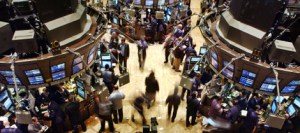 March 10, 2025
March 10, 2025
What You Need to Know Today:
Saturday Night Quarterback Part 2, on a Sunday says, For the week ahead expect…
This week its earnings, earnings, and earnings. From the tech giants and more. This week, we’ll discover three things. First, are tech company earnings as good as the market clearly expects. I think that with the exception of Apple (AAPL) and Tesla (TSLA) the answer will be Yes. Second, how much of this good news is already priced into the recent rally. These stocks could retreat even on news that’s as good as expected. An advance will, I think, require a surprise or two. And, third, how worried is Wall Street really, given the recent boom in all things AI, about capital spending at the big AI companies and falling profit margins.

Next Friday’s big number for inflation, interest rates, and the Fed
At 8:30 a.m. on Friday, December 6, investors will see the U.S. jobs report for November. Economists expect that the economy added 200,000 jobs in the month and that for the unemployment rate will hold steady at 4.2%.

More evidence that the inflation rate is stuck
Yesterday, Wednesday, November 27, the report from the Bureau of Economic Analysis showed that the Personal Consumption Expenditures index, the Federal Reserve’s preferred inflation measure, had continued the stall that began in May.

Today I made Verizon Pick #6 in my Special Report: “3 Strategies and 10 Picks for Juicy Returns in a Yield Drought”
Today I made Verizon the sixth pick in my Special Report “3 Strategies and 1O Picks for a Yield Drought.” Here’s what I wrote.

25% tariffs for Mexico, China, and Canada: This won’t be the last time Trump talks tariffs
Yesterday in social media posts President-elect Donald Trump said that he would impose tariffs on his first day back in office, targeting the United States’ three largest trading partners, of 25% on all goods from Canada and Mexico until drugs and migrants stopped coming over the borders, and an additional 10% tariff on all products from China, saying that the country was shipping illegal drugs to the United States. (The Biden Administration had already imposed its own higher tariffs on China and, in additional, it had kept tariffs on China from the first Trump Administration in effect.)

Biden proposes/Trump disposes: Will GLP-1 diabetes/obesity drugs become free under Medicare and Medicaid?
The Biden administration has proposed making GLP-1 weight loss drugs free for low-income people and retirees who qualify as obese. Expensive drugs such as Ozempic, Wegovy and Zepbound, which cost $1,000 a month, would be covered for the 40% of the U.S. population who qualify as obese. Currently, the federal plans only cover the drugs when patients have other conditions caused by obesity, such as diabetes, heart disease. The leading drugs are made by Eli Lilly (LLY) and Novo Nordisk (NVO). Shares of Eli Lilly were up 4.55% today while Novo Nordisk rose 1.50%. The incoming Trump Administration will have to decide whether to move ahead with the plan. You can either think of this as a smart piece of health care policy or an effort to jam up an incoming administration that already faces challenges in devising coherent policy on healthcare. I go with the “jam ‘em up” theory myself.

Special Report: 10 Penny Stock Homeruns #6 LYSDY
Lynas, one of the largest producers of rare earth minerals outside of China (and one of only two non-Chinese processors of rare earth minerals) is my sixth Penny stock pick for my Special Report.
Live Market Report (20 minute delay)

What to make of Cummins’ $2 billion penalty for Clean Air Act cheating
Here’s what an investor should watch after Cummins’ huge $2 billion Clean Air Act settlement.

Saturday Night Santa Claus says (on a Tuesday), For the week ahead expect…
Stocks continued on an upward path in a classic Santa Claus rally. Wall Street kicked off the final week of 2023 with gains in stocks, extending a rally that put the market on the brink of a record. Today, December 26, the Standard & Poor’s 500 traded about 0.5% away from its all-time high of 4,796.56. The so-called Santa Claus rally, which typically encompasses the last five trading sessions of the year and the first two of the new one, has a strong record of gains. Since 1969, the S&P 500 has averaged a gain of 1.3% over the seven-day period, according to the Stock Trader’s Almanac.

Don’t forget year-end tax loss harvesting–it could be extra valuable this year
You have until December 31–which effectively means Friday December 29 (although I wouldn’t push the deadline, personally) to sell your losers this year to off set any gains from winners you sold during the year. Given the way the year has unfolded, harvesting your tax losses to offset gains could be especially valuable this year.

Merry Christmas to all
I wish you all a Merry Christmas. Or a Happy Holiday of your choice. Hope Santa brings you everything you wished for. (And that you don’t get two more reindeer sweaters.) Looking forward to a more peaceful new year. One can always hope.

Is the good news priced in for Micron?
Right now memory chip maker Micro Technology (MU) is a microcosm of the stock market as a whole. There’s good news–pretty clearly–on the horizon. But the worry is that it’s already mostly priced into the stock. This week Micron, the largest U.S. maker of memory chips, gave a forecast for the fiscal second quarter that sure made it sound like the company, and the memory chip sector in general, was about to turn the corner after getting hammered on slumping demand for chips for personal computers and smartphones.

Bonds keep chugging higher, stock investors have doubts
Bond traders and investors kept the bond rally going today December 20. The yield on the 10-year Treasury dropped another 8 basis points to 3.85% today. The yield on the 2-year note fell 4 basis points to 4.40%. The drop in yields came as a result of gains in bond prices. On the other hand, the major stock indexes had a big down day. The Standard & Poor’s 500 fell 1.47% and the Dow Jones Industrial Average ended the day down 1.27%. The small-cap Russell 2000 dropped 1.86%. The NASDAQ Composite and the NASDAQ 100 soared 1.50% and 1.53%, respectively.. The differing results don’t reflect a divergence of views on interest rates–both bond and stock markets see the Federal Reserve cutting interest rates in 2024. The difference does, however, reflect differing views on valuation

U.S. oil production hits a record, destroying OPEC’s supply cut strategy
The world’s No. 2 oil producer, Saudi Arabia, wants to cut oil production to raise oil prices. And has even actually curtailed production to meet that goal. The world’s No 3 oil producer, Russia, wants (others mostly) to cut oil production to raise prices. And has even promised to cut its own production. (We’ll believe that when we see it.) But none of that matters because the world’s No. 1 oil producer, the United States, has put its foot to the accelerator and is producing at record volumes.

S&P 500 earnings on track to grow by just 0.6% in 2023
FactSet calculates that Wall Street analysts expect the S&P 500 to report earnings growth of 0.6% in calendar 2023. That’s way below the trailing 10-year average (annual) earnings growth rate of 8.4% for 2021 through 2022. So far on a quarterly basis, 2023 has shaped up this way: earnings declines of 1.7% and 4.1% for the S&P 500 in the first nd second quarters of 2023, respectively. And earnings growth of 4.9% for the third quarter. FactSet calculates that analysts expect the stocks in the index to report an earnings growth of 2.4% for Q4 2023.

Apple hit with patent judgment that puts quarterly sales growth in question
The hope among investors and on Wall Street was that Apple (AAPL) would show revenue growth when it reported its fiscal first quarter earnings in January. That growth would be the first in a year after four straight quarters of falling sales. That’s the longest streak of declining quarterly sales in two decades. But now a patent decision against Apple will take some of its best-selling Apple Watch series, the Series 9 and the Ultra2, off the market just as the holiday selling season is peaking.

Saturday Night Quarterback says, For the week ahead expect…
I expect the Federal Reserve to continue to try talking back some of the enthusiasm that greeted its December 13 meeting and the release of a new set of Dot Plot projections showing that the median forecast of staff and policy makers at the U.S. central bank called for three interest rate cuts in 2024.

Finally–Costco declares special $15 a share dividend; is membership increase next?
Costco Wholesale (COST) reported earnings for its fiscal first quarter of 2024 and declared a long anticipated special dividend of $15 a share. The stock closed up 4.61% on Friday, December 15.

Is the Fed “sorry” that it set off the latest rally?
Today sure sounded like policy-makers remorse from the Federal Reserve. New York Fed President, the vice-chair of the Federal Reserve’s interest-rate setting Open Market Committee, said that central-bank policy makers weren’t actively debating when to cut interest rates. That’s sure not what the stock market heard on Wednesday.

How many interest rate cuts will we see in 2024?
In its December revision of its Dot Plot projections for interest rates in 2024, the median projection by the U.S. central bank’s staff and policy makers estimated three interest rate cuts by the end of 2024. The market, which had been hoping for exactly this news, cheered, and stocks moved to record or near record highs. And in reaction to the Fed’s news, Wall Street moved its forecasts to match the new projection. Barclays, for example, is calling for three cuts in 2024 and JPMorgan Chase moved its forecast for the start of cuts to June. But, on Wall Street nothing exceeds like excess so projections are pushing beyond the Fed’s median view.

Troubles aren’t over for electric vehicle sales–will EV stocks feel the pain?
Electric vehicle inventories on lots at U.S. dealers reached a new high in December. With a 114-day supply, the bloated inventory of electric vehicles is up from a 53-day supply a year ago and compares to 71-days worth of inventory for the overall auto industry.

Solar stocks rocket higher on Day 2 of the post-Fed meeting rally
Among today’s big stock market winners today: SolarEdge Technologies (SEDG), the biggest maker of inverters used in turning sunlight into electricity, closed up 16.67%, and Sunrun (RUN), a leader in the installation of residential solar systems, closed up 19.92%. This rally had absolutely nothing to do with any news out of the recently ended COP28 United Nations Climate Conference. It was a pure reaction to the signs in yesterday’s Dot Plot from the Federal Reserve that the central bank was looking to cut interest rates at least three times in 2024. Makes perfect sense.

Moderna shares jump today on positive results in skin cancer vaccine trials
Shares of Moderna (MRNA) closed up 925% today, December 14. A personalized vaccine developed by Merck and Moderna helped prevent the recurrence of severe skin cancer for three years, according to new results released today. Patients with severe melanomas who got the vaccine and Merck’s cancer drug Keytruda were 49% less likely to die or have their cancer return than those who got Keytruda alone. The news is especially important for Moderna.

The Fed catches up with the markets on interest rate cuts and stocks soar
Today, the Federal Reserve caught up with the financial markets. The Fed’s Open Market Committee kept interest rates steady at a benchmark 5.25% to 5.50%, as expected. And the Fed’s Dot Plot projections showed that the median projection expects three interest rate cuts in 2024. That’s a huge shift from the September Dot Plot and moves the Fed toward the current Wall Street hope for 4 cuts or more in 2024. The Dot Plot also projects that the unemployment rate would rise slightly next year, to 4.1%, from a recent 3.7% rate, and that inflation would continue to improve in 2024 but not reach the Fed’s 2% target. Stocks soared on the confirmation of the consensus hope. At the close, the Dow Jones Industrial Average jumped 512.3 points, or 1.4%, to a record high of 37,090.24. The S&P 500 index climbed 1.37%, and the Nasdaq 1.38%.

Special Report: 10 Great Growth Stocks that Are Getting Greater–today my 7th pick ASML
GREATER Growth Stock Pick #7: ASML Holding (ASML). ASML Holding is priced like a stock that owns 90% of the market for cutting edge photo lithography chip-making equipment. I want to own this stock as one of my 10 GREATER Growth Stocks, but I worry about paying that kind of multiple (35 times trading 12-month earnings per share), especially ahead of what is shaping up as a challenging 2024 for chip equipment makers in general and ASML in particular. But 2025 looks like a great year for chip equipment makers in general and ASML in particular. So timing is the key issue on buying this one.

Core CPI inflation numbers disappoint for November, illustrate why the Fed won’t rush to cut rates
If you follow the headline numbers (what’s known as All Urban Consumers) for the Consumer Price Index (CPI), you’d say, “See inflation continues to fall; the Federal Reserve will cut rates quickly in 2024.” But you’d be following the wrong CPI number.

Special Report: 10 Great Growth Stocks that Are Getting Greater–today my 6th pick Danaher
GREATER Growth Stock Pick #6: Danaher (DHR). Danaher is a smart (that’s key) serial acquirer–and asset divester–in the life sciences space. And that makes this stock very interesting in an environment where small, young life sciences companies might be looking for help/rescue/acquisition because they can’t raise capital in a tough part of the credit cycle. I like Danaher now, as well, because the stock looks to have just about completed its re-rating after a spike in sales during the Covid pandemic led to over enthusiasm about the stock.



